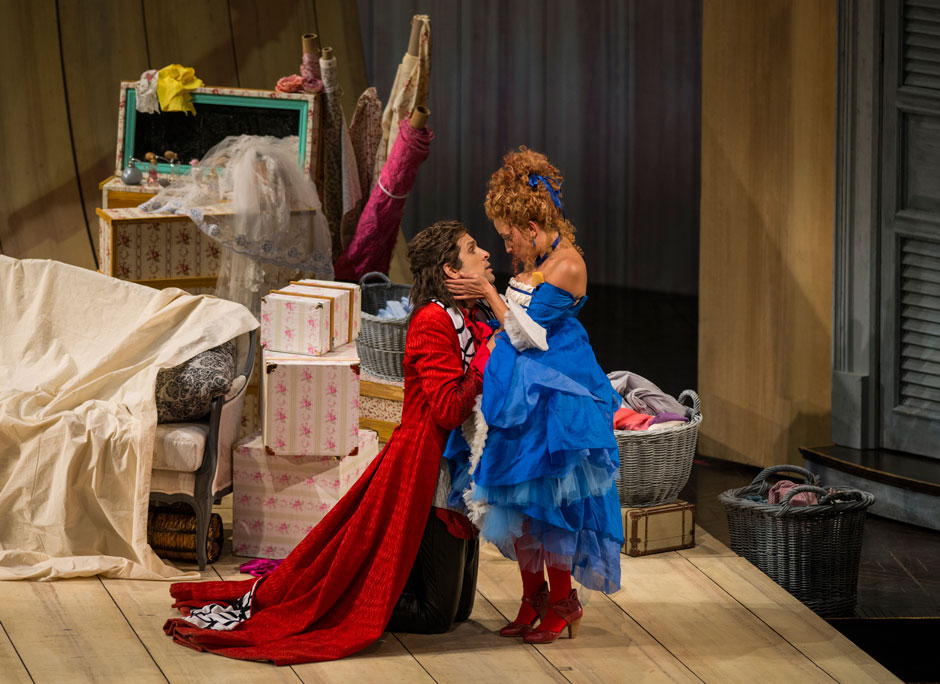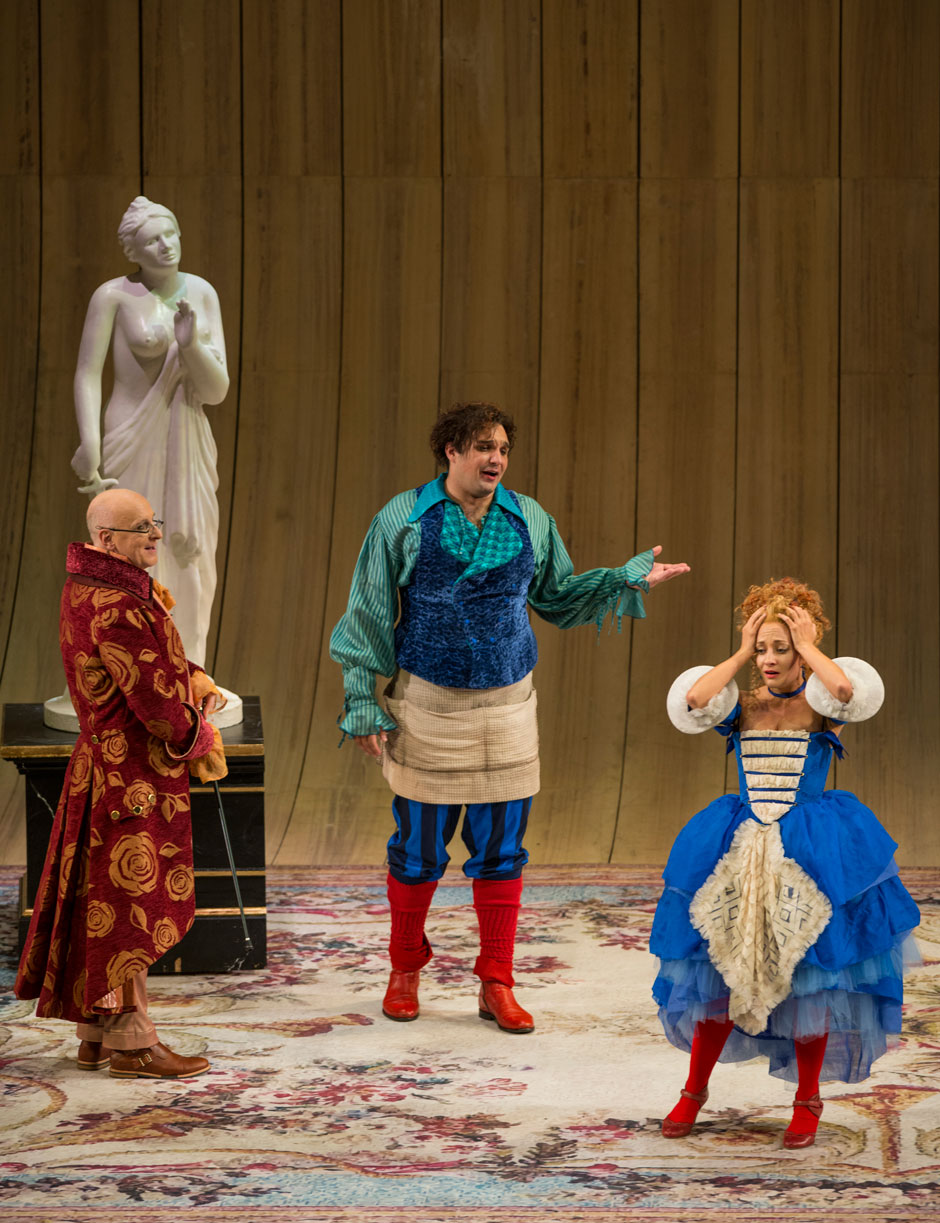Pierre Beaumarchais wrote three popular plays about Figaro—The Barber of Seville (1775), The Marriage of Figaro (1784), and The Guilty Mother (1784). In them, Figaro appears successively as fixer-upper barber to Count Almaviva, then valet to the Count, then chamberlain of the Count’s household.
Almaviva, the ardent young lover of a flirtatious girl, Rosina, in the first play, becomes the unfaithful husband of a neglected Rosina in the second. While the Countess laments her abandonment, the Count is working on a list of “conquests” to equal that of another Spanish lord, Don Giovanni. But while Don Giovanni finally gets his comeuppance, or rather his comedownance (straight to hell), there seems no way to stop Almaviva in his headlong lecheries. Even though Figaro helped him win Rosina in the past, the Count now wants to exercise his droit du seigneur over Figaro’s fiancé, Susanna.
How to change the Count’s sinful ways (without sending him to hell with Don Giovanni) is a problem for Mozart’s The Marriage of Figaro, which uses librettist Lorenzo da Ponte’s adaptation of Beaumarchais. An influential solution—given in Joseph Kerman’s justly famous book, Opera as Drama—is to redeem the Count through the love of a good woman. This conversion takes place, at the end of the opera, in the space of two simple lines. Almaviva, caught in flagrante, kneels down and pleads, “Countess, pardon, pardon,” and she answers, “I am submissive [docile], and say yes.” For Kerman, who is a very teleological critic of opera, this is the telos to which everything else in the opera is aimed. He says, to mark the importance of this exchange, that it begins with “a nervous staccato scale-figure in the violins, a newly serious harmonic progression,” which becomes “hymnlike” and “almost an epiphany.” He assures us that “the music at this section has a seriousness and a new clarity of feeling.”
That is a lot to load into two lines that usually take forty to sixty seconds to sing. If the person behind you coughs at this moment, you might miss part of one or the other line. Kerman admits these magic two lines need preparation to have such an outsize effect, and he finds that preparation in the opening of the second act, where the abandoned Countess, alone on the stage, sings the mournful “Porgi, amor”—“If you will not, Love, bring my husband back, then let me die.” This song, Kerman says, “moves the drama to a new plane.” The opera’s model was Italian opera buffa, and Kerman says even those frothy comedies had their serious moments—but not like this one. “No one before Mozart had been willing to assume the responsibility of this seriousness.” Here, the depth of the Countess’s sorrow reveals her profundity of soul, that store of spirituality that will pour out to change the Count in the work’s final scene: “I am submissive, and I say yes.”
The Lyric Opera of Chicago’s season-opening production of The Marriage of Figaro, directed by Barbara Gaines, the creator of the Chicago Shakespeare Theater, opens Act II seemingly in line with Kerman’s expectation of the “Porgi, amor.” The Countess sits all alone in the center of a vast bed (twenty-five feet wide, fifteen feet deep). Such a huge empty bed expresses her desertion. But then, in what must seem almost sacrilegious to a devout Kermanite, she crab-crawls over to the bedside, where there is a tray of sweetmeats, and starts stuffing bonbons into her mouth. When, shortly after, the Countess helps disguise the count’s page, the young boy Cherubino, as a woman, she takes advantage of a moment when no one is looking to swarm all over his body. This Countess has gone too long without sex.
Earlier, when the Count orders Cherubino into the army to get rid of him, Figaro sings of the boy’s new martial life to a stirring march, leading him in military drills. In this production, Susanna’s wide skirt hides what is going on while Figaro calls up a vision of military glory. When she finally moves aside, we see Cherubino bandaged and crippled as a war victim. Linking this and the earlier embrace by the Countess, I thought of Beaumarchais’s third Figaro play, The Guilty Mother, where the Countess is pregnant with Cherubino’s child when she hears of his death in battle. Gaines told me that she knows The Guilty Mother but had formed her concept without considering it. Her Countess is the frisky Rosina of old—Almaviva’s equal partner, not his saintly rescuer. The two even grab a moment for passionate embrace as they argue over his search for an elusive Cherubino.
Advertisement
Gaines lets us know early on that this is going to be a lusty romp, more in the vein of Fielding’s Tom Jones than of Kerman’s imagined play (something like The Sinner Reclaimed). As the overture is playing, a scream is heard from a woman in “naughty maid” costume running down the aisle, pursued by the Count in a long red robe that makes him look like Sargent’s portrait of the womanizing Doctor Pozzi now on display at the Metropolitan Museum. After the two duck under the curtain, the Countess comes after them in frustrated pursuit.
The opera buffa motif is reflected in the costumes (designed by Susan Mickey), which are flamboyant. Marcellina, the housemaid who lent Figaro money on a signed promise that he would marry her if he could not repay the loan, wears a hat that would do Carmen Miranda credit. The Countess herself is as oversequined as any Liberace. Some people resist the idea that such celestially beautiful music can float up from imperfect and lustful little people. But consider the duet of the Countess and Susanna, “Sull’ aria.” In the movie Shawshank Redemption, a prisoner sends that dreamlike moment by loudspeakers into the prison yard. Its aching beauty stops and stuns the inmates milling there. They cannot know that the two women are arranging a trap for the Count, meant to mislead so “He’ll take the hint” (capira).
The plot outlined in that duet is to be worked in a little grove (boschetto), and this last scene of switched identities and misconceptions is usually played in a palace garden with bushes and little pavilions in which the characters can hide from and observe each other in shifting configurations. Gaines stages this scene in a statuary garden, with idealized life-size Greek statues. With inspired mischief, she makes the garishly costumed characters show real life lurking behind sterile ideals. The scene ends with the two lines Kerman thinks are the whole point of the show. The line that redeems the Count is surprisingly meek: “I am submissive [docile] and I say yes.” We should remember here Rossini’s Barber of Seville, in which Rosino’s first aria says, “I am submissive [docile] and deferential [rispettosa], obedient, sweet, loving —BUT [a famous ma] if you cross me I’ll bring you down rather than give in.” In the Gaines conclusion, the Count and Countess splash water on each other from an onstage pond and their water fight ends with them embracing in the pond, playful as young lovers. And yes, Gaines tells me, she was thinking of baptismal water. She says, ‘Water cleanses”—she prefers that to Kerman’s redeeming superiority of the noble woman.
The Lyric Opera’s mainly young singers respond beautifully to the young (forty-year-old) Hungarian director Henrik Nánási. A tiny bundle of energy, he is the music director of the Komische Oper Berlin, so he knows his way around opera buffa. The orchestra is with him through all the hushed sequences of whispered schemings or braying moments of (mainly deceived) triumph. He is given great singing from a Czech Figaro, a German Susanna, an Italian Almaviva, and an Israeli Cherubino. Laughter knows no national boundaries.
Barbara Gaines’s production of The Marriage of Figaro is showing at the Lyric Opera of Chicago through October 24.




